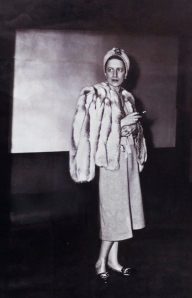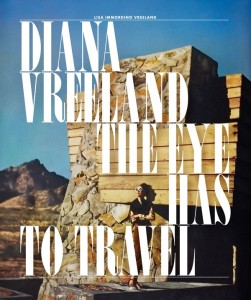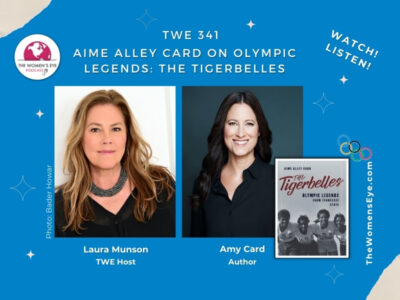UPDATE 2/21/13: Film debuts at Memphis Brooks Museum of Art
UPDATE 9/8/12: The new film, “Diana Vreeland: The Eye Has To Travel,” opens this month. Here is the trailer…
By Sue Podbielski/October 22, 2011
Facebook: DianaVreelandbookandfilm
Once upon a time there was a queen, who, despite her rather unconventional appearance, ruled the rarified world of women’s magazines with her ideas of fashion and beauty. She was Diana Vreeland, whose singular style catapulted her in the 1930s from socialite to Harper’s Bazaar’s fashion editor, a job she invented and held for almost three decades.
“There is only one thing in life and that’s the continual renewal of inspiration.” Diana Vreeland

She discovered Hollywood legend Lauren Bacall; launched the careers of models Twiggy and Jean Shrimpton; advised First Lady Jacqueline Kennedy on clothes; and became a major player during the heyday of women’s magazines. In 1963 Vreeland cemented her reputation by being named the Editor-in-Chief of Vogue where her contributions to the fashion revolution of the mid-sixties were innumerable.
I always found the indomitable Mrs. Vreeland, whom I worshipped from afar, to be a fascinating creature. Her personal panache, her jet black bob, her aquiline nose, and her gift for witticisms won me from the first moment that I read about her.
She once said, “The first thing to do is to arrange to be born in Paris. After that, everything follows quite naturally.” Diana Vreeland was one of the great figures of the New York City fashion and art world until her death in 1989.
Her larger than life persona (she was the inspiration for the character of Maggie Prescott in the Fred Astaire-Audrey Hepburn film “Funny Face”) may have been her own creation, but it was nevertheless mesmerizing.
When The Grolier Club (a place apparently so unique that had I never even heard about it in my 30 -something years of living in New York) announced a lecture by Vreeland’s granddaughter-in-law Lisa Immordino Vreeland, I eagerly paid the thirty dollars for the ticket and joined the crowd of 25 or so D.V. acolytes to hear what she had to say.

Immordino Vreeland, a striking woman with a professional background in fashion, has written a new book, “Diana Vreeland: The Eye Has to Travel” which chronicles Mrs. Vreeland’s life in style. Many have said that Diana (pronounced DEE-ahna) Vreeland gave us the template for the way we view and interact with fashion today, and Immordino Vreeland makes a very strong case for that.
While she never met her grandmother-in-law, she had access to the family’s archives as well as those of Bazaar, Vogue, and the Metropolitan Museum’s Costume Institute, for which Diana Vreeland served as creative consultant after her abrupt dismissal from Vogue at the age of 70.
Immordino Vreeland was a prodigious researcher on this project leaving no stone of D.V.’s life as an editor unturned. While she was researching the book, an impressive coffee-table tome featuring hundreds of photos pulled from the pages of Vogue and Harper’s Bazaar, she told herself that she should be working on a documentary. So that’s exactly what she ended up doing.
Her impressive film, which debuted at the Venice Film Festival and will be released by the Samuel Goldwyn Company in March 2012, features interviews with Calvin Klein, Angelica Huston, Ali McGraw, Marisa Berenson, Oscar de La Renta, Hubert de Givenchy, Diane von Furstenberg, Manolo Blahnik, and Vreeland’s most celebrated collaborator, photographer Richard Avedon.
“You’ve got to give people what they can’t get at home. You’ve got to take them somewhere.”
Then, there is Diana Vreeland in her own words, captured on video and audio tapes in interviews she did with Dick Cavett and Diane Sawyer, as well as many hours of conversations recorded with the writer George Plimpton, made while she wrote her memoir, D.V. Vreeland once said, “You’ve got to give people what they can’t get at home. You’ve got to take them somewhere.” Her vehicle for this journey was fashion, but her route was fantasy.

Diana Vreeland gave people a sense of something larger than life, although not always factual. According to Immordino Vreeland, she was a believer in “faction,” the synergy between fantasy and fact. “Do we know for certain that Nijinsky danced through her living room?” says Immordino Vreeland. “We don’t. But does it matter? She puts us there. She gives us a sense of history in a totally different way.”
Vreeland had a front row seat to the most important moments of her time, and it made everything she said and did more alive. She danced alongside Josephine Baker in Harlem; she rode with Buffalo Bill; she shopped at Coco Chanel’s atelier; and she witnessed the coronation of King Edward VI.
It was all a magnificent prelude for the woman who would introduce, despite indignant protestations, the bikini and blue jeans to American fashion, calling them “the most beautiful things you’ve ever seen.” Everything she did was extraordinary and extreme. Not surprisingly, she loved the Sixties. “For the first time,” she said, “youth went after life instead of waiting for life to come to them.”
I asked Immordino Vreeland during the recent lecture what Diana Vreeland might have thought of today’s fashion. She answered that she probably would be very pleased with much of what she saw, particularly how accessible fashion has become today. She thought Vreeland would have really loved the internet because she loved learning about new things and tapping into trends and information all over the world. Vreeland once said, “There is only one thing in life and that’s the continual renewal of inspiration.”
She brought creativity, inspiration, and fantasy to an industry which needed her talent.
For those who are interested in Diana Vreeland’s personal life and how she came to be the fascinating woman she ultimately became, Immordino Vreeland offers glimpses but no conclusions.

According to interviews with Vreeland herself, she always had a unique appearance which prompted her mother to call her, “my little monster.” Her younger sister, Alexandra, was considered to be beautiful.
What this did to a vulnerable young Diana Vreeland we can only conjecture. One has the vision of a girl growing up in a world of beauty and culture who, although not considered beautiful herself, was determined to turn herself into the ultimate arbiter of fashion and taste.
The wonderful thing is that while she may have created her own persona and played the role to the hilt, she gave so much to life. Whether she was being real or acting a part didn’t seem to matter. Yes, she was bending reality to fit her will, but she was awfully good at it.
Immordino Vreeland paints a vivid portrait of a complex woman whose talents could not be categorized and whose imagination was so vast that she had to invent a place for herself in the world. More than anything Diana Vreeland was about ideas. She brought creativity, inspiration, and fantasy to an industry which needed her talent. And that industry became her all-important vehicle. It was a match made in heaven.
Book Credit: Abrams, Fall 2011. That is Diana Vreeland on the cover, posing in front of Frank Lloyd Wright’s Taliesin West. The model was sick that day and D.V. just decided to do the shoot herself.
###
Sue Podbielski is a writer, producer, and community activist.




Leave a Reply